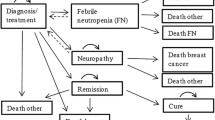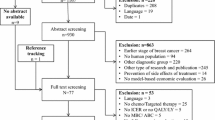Abstract
Objective: To compare clinical and economic study data for docetaxel, paclitaxel and vinorelbine in the treatment of anthracycline-resistant advanced breast cancer.
Study design and methods: A Markov decision-analysis model to simulate the clinical course of a ‘typical’ patient with advanced breast cancer during salvage chemotherapy was updated with response rates and adverse effect rates from phase III clinical trial data for docetaxel, paclitaxel and vinorelbine. Costs were taken from UK national databases and hospitals. Utilities were estimated from 30 oncology nurses in the UK using the standard gamble method.
Perspective: National Health Service.
Results: When compared with other chemotherapeutic agents, docetaxel has been shown to increase response rate, time to progression and survival in patients with advanced breast cancer. In the base-case analysis, the incremental cost-utility ratio for docetaxel versus paclitaxel was £1995 per quality-adjusted life year (QALY) gained (1998 values). The incremental cost-utility ratio for docetaxel versus vinorelbine was £14 055 per QALY gained. In the comparison with vinorelbine, docetaxel provided the equivalent of an additional 92 days of perfect health. Sensitivity analyses confirmed the robustness of the model and the validity of the base-case analysis results. Even in the worst case scenarios, docetaxel remained cost effective compared with paclitaxel and vinorelbine.
Conclusions: These findings support the use of the taxoids, notably docetaxel, in the management of advanced breast cancer.







Similar content being viewed by others
References
Nabholtz J-M, Senn HJ, Bezwoda WR, et al. Prospective randomised trial of docetaxel versus mitomycin plus vinblastine in patients with metastatic breast cancer progressing despite previous anthracycline-containing chemotherapy. J Clin Oncol 1999; 17: 1413–24
Sedlacek SM. Salvage therapy for metastatic disease. Semin Oncol 1990; 17 Suppl. 7: 45–9
Nabholtz J-M, Gelmon K, Bontenbal M, et al. Multicentre, randomised comparative study of two doses of paclitaxel in patients with metastatic breast cancer. J Clin Oncol 1996; 14: 1858–67
Chan S, Friedrichs K, Noel D, et al. Prospective randomised trial of docetaxel versus doxorubicin in patients with metastatic breast cancer. J Clin Oncol 1999; 17: 2341–54
Jones S, Winer E, Vogel C, et al. Randomised comparison of vinorelbine and melphalan in anthracycline-refractory advanced breast cancer. J Clin Oncol 1995; 13: 2567–74
Sjöström J, Blomqvist C, Mouridsen H, et al. Docetaxel compared with sequential methotrexate and 5-fluorouracil in patients with advanced breast cancer after anthracycline failure: a randomised Phase III study with crossover on progression by the Scandinavian Breast Group. Eur J Cancer 1999; 35: 1194–201
Brown RE, Burrell A. The economic advantages of response in the treatment of advanced breast cancer. J Med Econ 1999; 2: 57–63
Revicki DA, Kaplan RM. Relationship between psychometric and utility-based approaches to the measurement of health-related quality of life. Qual Life Res 1993; 2: 477–87
Hutton J, Brown R, Borowitz M, et al. A new decision model for cost-utility comparisons of chemotherapy in recurrent metastatic breast cancer. Pharmacoeconomics 1996; 9 Suppl. 2: 8–22
Leonard R, Jowell A. A systematic review of docetaxel, paclitaxel and vinorelbine in the treatment of advanced breast cancer. Adv Breast Cancer 2000; 2: 1–7
Dieras V, Marty M, Tubiana N, et al. Phase II randomised study of paclitaxel versus mitomycin in advanced breast cancer. Semin Oncol 1995; 22 Suppl. 8: 33–9
Seidman AD, Tiersten A, Hudis C, et al. Phase II trial of paclitaxel by 3-hour infusion as initial and salvage chemotherapy for metastatic breast cancer. J Clin Oncol 1995; 13: 2575–81
Fountzilas G, Athanassiades A, Giannakakis T, et al. A phase II study of paclitaxel in advanced breast cancer resistant to anthracyclines. Eur J Cancer 1996; 32A: 47–51
Michael M, Bishop JF, Levi JA, et al. Australian multicentre phase II trial of paclitaxel in women with metastatic breast cancer and prior chemotherapy. Med J Aust 1997; 166: 520–3
Vici P, DiLauro L, Conti F, et al. Paclitaxel activity in anthracycline refractory breast cancer. Tumori 1997; 83: 661–4
Pugliese P, Brugnatelli S, Giordano M, et al. Paclitaxel in anthracycline-treated breast cancer patients. Oncol Rep 1998; 5: 915–8
Torrance GW. Utility approach to measuring health-related quality of life. J Chron Dis 1987; 40: 593
Furlong W, Feeny D, Torrance GW. Guide to design and development of health state utility instrumentation. Hamilton (ON): McMaster University, 1990
Netten A, Dennet J, Knight J. Unit costs of health and social care. Kent: Personal Services Research Unit at Kent University, 1998
MIMS. Monthly Index of Medical Specialties. London: Haymarket Publishing Services Ltd, 1999 Aug
Joint Government/Pharmaceutical Industry Working Party. UK guidance on good practice in the conduct of economic evaluations of medicines. BMJ Econ 1994; 7: 63–4
Miller AB, Hoogstraten B, Staquet M, et al. Reporting results of cancer treatment. Cancer 1981; 47: 207–14
Stevens A, Colin-Jones D, Gabbay J. ’Quick and clean’: authoritative health technology assessment for local health care contracting. Health Trends 1995; 27: 37–42
Anonymous. AQALYof 30,000 BPS is increasingly being seen as the cut-off point for a positive NICE submission. Script 2001 Oct 19: 2
Launois RJ, Reboul-Marty JM, Bonneterre J. A cost-utility analysis of second line chemotherapy in metastatic breast cancer: docetaxel versus paclitaxel versus vinorelbine. Pharmacoeconomics 1996; 10: 504–21
Brown RE, Hutton J. Cost-utility model comparing docetaxel and paclitaxel in advanced breast cancer patients. Anticancer Drugs 1998; 9: 899–907
Leung PP, Tannock IF, Oza AM, et al. Cost-utility analysis of chemotherapy using paclitaxel, docetaxel, or vinorelbine for patients with anthracycline-resistant breast cancer. J Clin Oncol 1999; 17: 3082–90
Acknowledgements
Model development supported by a grant from Rhone-Poulenc Rorer, now Aventis.
Author information
Authors and Affiliations
Rights and permissions
About this article
Cite this article
Brown, R.E., Hutton, J. & Burrell, A. Cost Effectiveness of Treatment Options in Advanced Breast Cancer in the UK. Pharmacoeconomics 19, 1091–1102 (2001). https://doi.org/10.2165/00019053-200119110-00003
Published:
Issue Date:
DOI: https://doi.org/10.2165/00019053-200119110-00003




